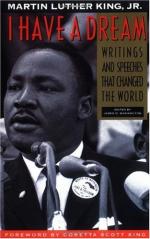
|
| Name: _________________________ | Period: ___________________ |
This test consists of 15 multiple choice questions and 5 short answer questions.
Multiple Choice Questions
1. Who introduced Dr. King for his last and final sermon?
(a) Lyndon B. Johnson.
(b) Ralph Abernathy.
(c) Michael Schwerner.
(d) Stokely Carmichael.
2. According to Chapter 16 "A Time To Break Silence," who did the United States find it "easier to engage in warfare" as opposed to the Soviet Union?
(a) The Koreans.
(b) The French.
(c) The citizens of the U.S.
(d) People of color.
3. Who did Dr. King go to help in Memphis, Tennessee, during a strike against unfair labor practices?
(a) African American dock loaders.
(b) African American farm workers.
(c) African American factory linesmen.
(d) African American sanitation workers.
4. What was the publication date from Dr. King's article from Chapter 17: "Black Power Defined"?
(a) July 11, 1968.
(b) June 11, 1967.
(c) December 5, 1955.
(d) August 5, 1965.
5. Who was sworn into the presidency following the assassination of JFK?
(a) Dwight D. Eisenhower.
(b) Richard M. Nixon.
(c) Gerald R. Ford.
(d) Lyndon Johnson.
6. According to Chapter 18: "Where Do We Go From Here," what "spawned" the Cold War?
(a) Mild disagreements.
(b) Need for power.
(c) Mutual fear and hostility.
(d) Hatred.
7. What were Dr. King's political sentiments?
(a) Liberal Republican.
(b) Democratic Socialist.
(c) Liberal Democrat.
(d) Republican Socialist.
8. What was the name of the 37-year-old NAACP field secretary murdered on his front porch on June 12, 1963?
(a) W.E.B. Du Bois.
(b) Medgar Evans.
(c) William Pickens.
(d) Robert Bagnall.
9. What was Martin Luther King, Sr.'s, nickname?
(a) Father M.
(b) Father K.
(c) Daddy King.
(d) Daddy Martin.
10. What was the ethnicity of the people who attended the anti-war demonstration that Dr. King led?
(a) Hispanic, black, and white.
(b) Black and white.
(c) Black only.
(d) White only.
11. What year was the atom bombed dropped on Hiroshima and Nagasaki?
(a) 1945.
(b) 1965.
(c) 1975.
(d) 1955.
12. What was the true goal of the Black Power Movement?
(a) For African Americans to be more conscious of their history and culture.
(b) To help African Americans become more "white."
(c) To create a support circle to fight against the KKK.
(d) For African Americans to fight for their freedoms.
13. What national convention did Reverend A.D. Williams, Martin Luther King, Sr.'s, maternal grandfather, found?
(a) National Religious Convention.
(b) National Baptist Convention.
(c) National Pastoral Convention.
(d) National African American Convention.
14. What must people of oppression accumulate to realize deliverance?
(a) The heart to want change.
(b) The consciousness of a problem.
(c) The power to enforce change.
(d) The right to enforce change.
15. According to the chapter "Black Power Defined," what do the "powerful" never lose?
(a) Themselves.
(b) Opportunities.
(c) Chances.
(d) War.
Short Answer Questions
1. On what date were excerpts from the sermon from Chapter 19: "The Drum Major Instinct" played for Dr. King's nationally televised funeral service?
2. What two cities had riots erupt on July 18, 1964?
3. When did Dr. King deliver his last, and greatest, sermon?
4. What war began to take precedence over the Civil Rights Movement given that military presence was needed?
5. When did Dr. King deliver his last SCLC presidential address?
|
This section contains 477 words (approx. 2 pages at 300 words per page) |

|




